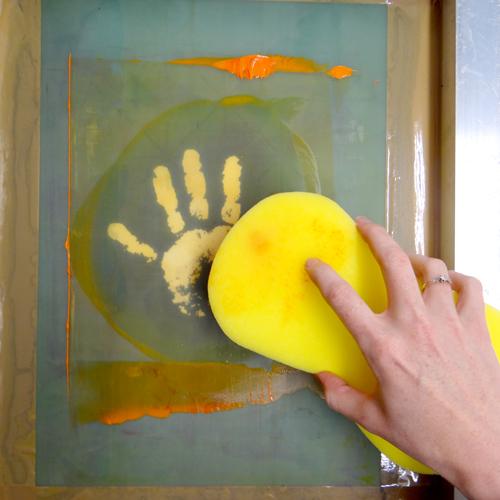Caring for an Exposed Screen

It’s important to take care of your exposed screen so that it can last for multiple print runs. With proper care, you should be able to use your screen again and again until you’re ready to have it washed off and a new design exposed. The amount of time your screen can be used depends on many things, including how you care for it, the inks you are using and the detail on your design.
Read on for a list of rules and advice on taking care of your exposed screen:
- Never let ink dry in your mesh. Once ink has dried it can be almost impossible to remove, especially if you want to keep your emulsion intact. Zest-it Printmaker's Washdown can help remove dried in ink but this may not remove all of it. Sometimes a jet wash will remove some of the ink but this will damage your emulsion. Usually, if ink dries in the screen it will cause a permanent blockage and might need to be re-meshed. Opaque inks and metallic inks tend to dry a little faster than standard screen printing inks.

- Keep a bucket of cold water and a soft car sponge with you whilst you work. This helps to prevent any ink drying in the screen. After a print run or when pausing from printing for a tea break or to organise your next prints, wring out the sponge and gently wipe over the mesh on both sides. You should see the ink leaving the design and light should start to show through. At this stage don’t worry about cleaning the taped edges of the screen too much. This way, your mesh stays clean but you don’t have to re-register your frame or wait for ages for the screen to dry. This is particularly useful when printing with hinge clamps or a vacuum bed.

- Clean your screen with cold water using a garden hose or shower hose. You don’t need a pressure hose – this could damage the emulsion. Don’t use any cleaners, chemicals or soaps.
- Use only soft sponges to clean your screen. Don’t use brushes. Use separate sponges so they do not become contaminated with other chemicals and solutions that could damage your emulsion.
- Ideally you should use Blue Block Out tape if tape is needed, this tape has less tack and is designed not to damage emulsion. When using any tape it is advisabale to take off the tape after each print run. Usually, we need to tape the edges of our screen to cover up areas of open mesh. Occasionally, we also may tape over other areas of the screen. It’s important that this tape doesn’t stay on for too long as it is likely to damage emulsion and becomes harder and harder to remove the longer it is left on. Try not to put any tape over areas of the design. Use glossy magazine pages to cover these up when printing instead if necessary.
- Keep your screen away from any sharp corners or objects as they can pierce the mesh.
- Sometimes pinholes may appear in your screen. The emulsion can wear and little holes can appear that may let ink through to your print. Occasionally, these appear on a newly exposed screen. If this happens, the holes can be easily filled with sensitised emulsion or screen filler. Just paint a small, thin patch over the hole and leave to dry. You can also use a little piece of tape to cover any emulsion holes if you prefer.

- Store your screen out of strong sunlight. Occasionally, emulsion can super-harden if exposed to too much light. This makes the emulsion almost impossible to remove which can be frustrating when you’re ready for your next design.
- Use only suitable inks: pre-mixed screen printing inks such as Speedball Fabric Ink, Speedball Acrylic Ink or Permaset can be used straight out of the pot. If you want to print with acrylic paint you’ll need make a mix that is at least 50% acrylic screen printing medium for printing onto paper or textile screen printing medium for printing onto fabric. For printing onto fabric you can also use pigment and binder.
For more information on our exposed screen service, click here or read our custom screen terms and conditions.
